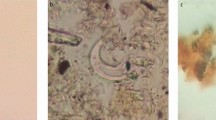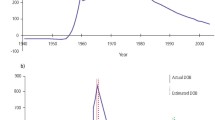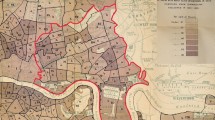Key Points
-
Discusses the information that can be extracted from teeth.
-
Teeth provide kymographic records of lives lived from womb to tomb. Interpretation of this odontological information provides much to chew on.
-
Discusses the definition of teeth.
Abstract
The role of teeth as lifestyle indicators of the past and present, and as key elements of evolutionary and forensic studies is explored. The wisdom of entrenched information in the structure of enamel, dentine and the DNA of dental pulp cells is being extracted by new technologies.
Similar content being viewed by others
Introduction
'The tooth, the whole tooth and nothing but the tooth' (parody on legal witness declaration oath sworn before presenting evidence).
Teeth form such a prominent component of human facial aesthetics by virtue of their lustrous image that they invite comparison with jewellery. The mythical tooth fairy fantasy presents shed deciduous teeth as jewels to be exchanged for monetary values. Indeed, teeth have been used as jewellery by various tribes.
Teeth are often referred to as 'pearly whites' which may have led to cosmetic tooth-whitening procedures to obtain a 'brighter more vibrant smile'! A whole aesthetic industry has sprung up providing tooth whitening by aesthetic specialists or by self-whitening kits.
The role of teeth as biting instruments is well-established, but has been expanded in the world of entertainment by a comedy-horror movie film titled 'Teeth' that premiered at the Sundance Film Festival in 2007 and received the Grand Jury Prize for acting! Finally, the 'vagina dentata' myth is given credence by case reports of ovarian hamartomas containing teeth.
Palaeontological considerations
Teeth are pearls of disclosure and wisdom in potentially revealing evidence of human evolution and much of the life history of individuals. Teeth provide insights into biological, ecological, behavioural, living conditions and past history of dentate populations. Indeed, 'the tooth was pearl white, in beautiful condition' in the initial discovery of the fossil Australopithecus sediba.1
Teeth contain information not only by their external appearance but also within their entombed pulp chambers. Teeth are compendiums of evidence for the identification of the genera of Australopithecus and Homo because they are the most frequently preserved and discovered fossils. Teeth play an irreplaceable role in tracing human evolution. The establishment of an early modern human presence in Sumatra, South East Asia 73,000–63,000 years ago was based upon the evidence of two fossil human teeth subjected to electron spin resonance dating (ESR).2 Further, the teeth displayed anatomically modern enamel-dentine junction morphology, typically thick enamel and incisor double-shovelling. Newly-discovered fossils from Morocco expand the range of Homo sapiens fossils.3 The recently discovered deciduous lower second molar fossil adds Denisovans, a sister group of Neanderthals, to the hominin lineage.4 As the most durable remnants of biological structures of the past, teeth are often the only elements of identification and description of newly discovered taxons.5 The role of teeth in defining taxons, genera and species extends back to the late Cretaceous Period, 71 million years ago. Since the discovery of Troodon formosa, based on an isolated tooth,6 troodontid teeth are the most singular elements of description of newly-discovered species living in the late Cretaceous Period. The discretely different morphologies of their teeth were the criteria separating closely related species.
Having the most prolonged duration of gestation of any organ of the human body, the dentition harbours more information of its existence than any other components of the body. Starting at six weeks after conception, the full completion of the dental apparatus does not occur until the eruption of the wisdom teeth at 18 to 20 years of age. Herein lies a treasury of information. The very appellation of 'wisdom' to the last erupting molar teeth, supposedly indicative of having achieved sapient knowledge, gave rise to the nomenclature of our species, Homo sapiens.7,8 The adoption of 'Wisdom' as a trademark name by William Addis for his invention of the modern toothbrush 235 years ago, and still in business, further attests to the association of teeth with wisdom (www.wisdomtoothbrushes.com).9
The containment of both external evidence of a life lived and internal constituents of our genetic inheritance are lodged in the DNA of the pulps of our teeth. Our dentitions contain an unique historical inscription of our existence and evolution.10 The rate of enamel formation deciphered from the intervals in the striae of Retzius provides insights into the earliest known instances of modern life history.11 Dental microstructure provides evidence of growth rates, developmental phenomena and life history. Dental microwear analysis provides insights into jaw movements and tooth use.
Dental age determination
As an indicator of age, teeth are unparalleled in providing evidence of anility. The curious concept of the upper canine tooth being the 'eye-tooth' arose from the belief of the unproven relation of the canine tooth being connected to the eye. However, the belief in the eruption of one's eye-teeth ('to cut one's eye-teeth') signifies the transition from babyhood to childhood.12 The aphorism 'long in the tooth', consequent to gingival recession exposing roots, reveals the aging phenomenon. The depth of the 'mark' in horse incisors, in which a deep indentation in the incisal edge is gradually worn away as a horse ages, is indicative of the age of a horse. Hence, the expression 'don't look a gift horse in the mouth' arose. The degree of attritional wear on teeth provides an approximate age of an individual, which, of course, is dependent on the nature of the diet consumed.13 Electron spin resonance dating of the apatite crystals contained in enamel might provide evidence of the age of fossilisation and environmental markers.14
Dental practice
Evidence for the earliest practice of 'dentistry' or dental hygiene has been elicited from tooth pick grooves discovered in 1.84 million-year-old Homo habilis specimens.15 However, evidence of dental manipulative intervention for alleviation of pain or irritation caused by a misaligned impacted wisdom tooth has been reported in a 130,000-year-old Krapina Neanderthal fossil.16 Teeth as artefacts of artistic or cultural expression by mutilation and modification have been explored.17 The evidence elicited of the Neanderthal diet and disease from ancient DNA in dental calculus has been reported.18
The carving and sculpting of ivory derived from the canines, incisors or dentitions of elephants, hippopotamuses or sperm whales constitutes a whole separate category of dental craftsmanship.19
Forensic examination of teeth in dento-legal investigations disclosing the identification of victims of violent deaths by accidents or crimes often relies exclusively upon recognition and interpretation of the evidence educed from dental remains. The discovery of King Richard III's skeleton confirmed the identity of the long-deceased monarch by DNA prints obtained through his recovered dental pulp cells compared with the DNA of his living descendants.20 The genetic origins of the Bronze Age Minoans (2900–1700 BCE) and the Mycenaeans (1700–1200 BCE) were identified by genome-wide ancient DNA data extracted from the teeth of 19 ancient individuals.21
The different roles of teeth
The unlikely determination of the diets of lions (Panthera leo) by examining dental microwear textures has been revealed by examining the dentitions of captured lions.22 The revelation of man-eating by these feline hunters' dentitions is extraordinary.
Finally, the definition of what are 'teeth' has been expanded to include the 'vagina dentata' of female cabbage white butterflies (Pieris rapae) that possess a jaw-like structure called a signum, complete with rows of 'teeth' that sit within their reproductive organs that they use to rip through and break open the hard encasing of a male's ejaculated spermatophore!23,24 A further genitodental curiosity is found in the enigmatic endophallus of the male seed beetle (Callosobruchus subinnotatus) whose odontognathic copulatory organ contains teeth.25 Experimental smoothening of these teeth with a dental drill (Two striper L201MF3) was performed to assess the function of the jaw-like structure, providing yet another opportunity for dentists to employ their operating skills. Who would have conceived of teeth in these bizarre contexts? Yet, the occurrence of teeth in human reproductive organs gives credence to the 'vagina dentata' myth by case reports of ectopic teeth in ovarian teratomas.26
Conclusion
The study of teeth for their evolutionary evidence and as organs of facial aesthetics, as predatory and prehensile instruments, adds to their masticatory, triturating, gnashing and gnawing functions.
References
Berger L, Hawks J . Almost Human. National Geographical Society: Washington DC, 2017.
Westaway, K E, Louys J, Due Awe R et al. An early modern human presence in Sumatra 73,000-63,000 years ago. Nature 2017; 548: 322–325.
Hublin J-J, Ben-Ncer A, Bailey S E et al. New fossils from JebelIrhoud, Morocco and the pan-African origin of Homo sapiens. Nature 2017; 546: 289–292.
Slon V, Viola B, Renaud G et al. A fourth Denisovan individual. Sci Adv 2017; 3: E1700186.
Leidy J . Notices of remains of extinct reptiles and fishes, discovered by Dr. F V. Hayden in the badlands of the Judith River, Nebraska Territory. Int Proc Nat Acad Sci 1856; 8: 72–73.
Evans D C, Cullen T M, Larson D W, Rego A . A new species of troodontid theropod (Dinosauria: Maniraptora) from the Horshoe Canyon Formation (Maastrichtian) of Alberta, Canada. Can J Earth Sci 2017; 54: 813–826.
Clement J . Summary of: Estimating age and the likelihood of having attained 18 years age using mandibular third molars. Br Dent J 2010; 209: 406–407.
Cardoso H F V, Caldas I M, Andrade M . Dental and skeletal maturation as simultaneous and separate predictors of chronological age in post-pubertal individuals: a preliminary study in assessing the probability of having attained 16 years of age in the living. Austral J Forensic Sci 2016; 10.1080/00450618.2016.1237548.
Wisdom. Homepage. Available online at www.wisdomtoothbrushes.com (accessed October 2017).
Sperber G H . Forensic odontostomatology. Forensic Med Anat Res 2013; 1: 87–89.
Smith T M, Tafforeau P, Reid D J et al. Earliest evidence of modern human life history in North African early Homo sapiens. Proc Natl Acad Sci U S A 2007; 104: 6128–6133.
Onions C T . The Shorter Oxford English Dictionary. 3rd edition. Oxford: Clarendon Press, 1959.
Sperber G H . Dental wear: Attrition, Erosion and Abrasion. Dent J 2017; 5: 10.3390/dj5020019.
Gonzalez J L, Pell A, Lopez-Mesas M, Valiente M . Simultaneous determination of BTEX and their matabolites using solid-phase microextraction followed by HPLC or GC/MS: An application in teeth as environmental biomarkers. Sci Total Environ 2017; 603–604: 109–117.
Ungar P S, Grine F E, Teaford M F, Perez-Perez A . A review of interproximal wear grooves on fossil hominin teeth with new evidence from Olduvai Gorge. Arch Oral Biol 2001; 46: 285–292.
Frayer D W, Gatti J, Monge J, Radovcic D . Prehistory dentistry? P4 rotation, partial M3 impaction, toothpick grooves and other signs of manipulation in Krapina Dental Person 20. Bull Int Assoc Paleodont 2017; 11: 1–10.
Milner G R, Larsen C S . Teeth as artefacts of human behaviour: intentional mutilation and accidental modification. In Kelly M A, Larsen CS (Eds) The History of Dental Anthropology. Springer: Heidelberg, 1991.
Weyrich L S, Duchnes S, Soubrier J et al. Neanderthal behaviour, diet and disease inferred from ancient DNA in dental calculus. Nature 2017; 544: 357–361.
Sperber GH . Tupilaks, scrimshaw and netsukes. J Canad Dent Assoc 1986; 5: 373–374.
King T E, Gonzalez Fortes G, Balaresque P et al. Identification of the remains of King Richard III. Nat Commun 2014; 5: 5631.
Lazardis I, Mittnik A, Patterson N et al. Genetic origins of the Minoans and Mycenaeans. Nature 2017; 548: 214–218.
De Santis L R G, Patterson B D . Dietary behaviour of man-eating lions as revealed by dental microwear textures. Sci Rep 2017; 7: 904.
Morehouse N . Image of the Day: Teeth. The Scientist 2017. Available at http://www.the-scientist.com/?articles.view/articleNo/49776/title/Image-of-the-Day--Teeth/ (accessed October 2017).
Meslin C, Cherwin T S, Plakke M S et al. Structural complexity and molecular heterogeneity of a butterfly ejaculate reflect a complex history of selection. Proc Natl Acad Sci U S A 2017; 114: E5406–E5413.
Van Haren M M, Ronn J L, Schilthuizen M, Arnqvist G . Postmating sexual selection and the enigmatic jawed genitalia of Callosobruchus subinnotatus. Biol Open 2017; 6: 1008–1012.
Ingate Y, Shankar A A, Routray S et al. Ectopic teeth in ovarian teratoma: a rare appearance. Case Rep Dent 2013; 2013: 970464.
Author information
Authors and Affiliations
Corresponding author
Additional information
Refereed Paper
Rights and permissions
About this article
Cite this article
Sperber, G. Teeth as pearls of wisdom. Br Dent J 223, 787–788 (2017). https://doi.org/10.1038/sj.bdj.2017.987
Accepted:
Published:
Issue Date:
DOI: https://doi.org/10.1038/sj.bdj.2017.987



